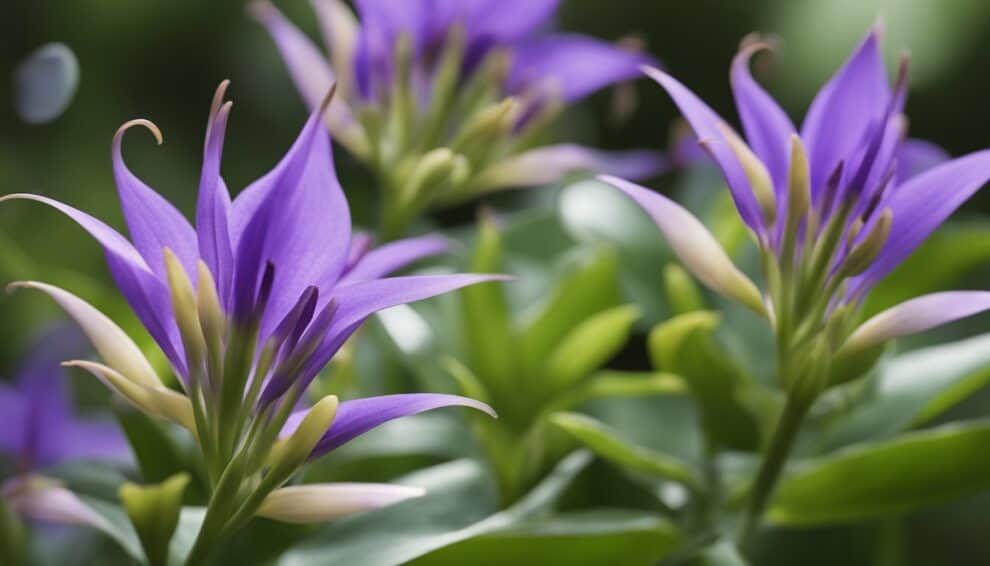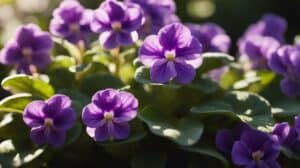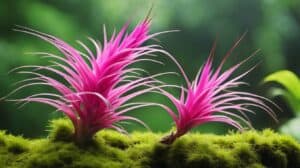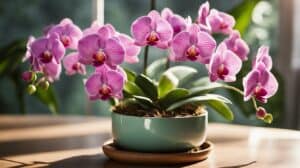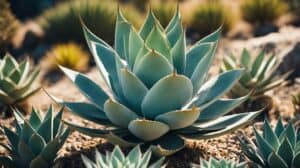Beschorneria Yuccoides, also known as Mexican Lily, is a unique plant species native to the highlands of central Mexico.
It belongs to the Asparagaceae family, which also includes other popular ornamental plants such as asparagus and agave.
Unlike most lilies, Beschorneria Yuccoides is not grown for its flowers, but rather for its striking foliage and architectural form.

Beschorneria Yuccoides is a rosette-forming perennial that can reach up to 4 feet in diameter and height.
Its long, narrow leaves are bluish-green and can grow up to 3 feet long and 2 inches wide.
The leaves have a smooth texture and are arranged in a spiral pattern, giving the plant a unique and eye-catching appearance.
In the summer, Beschorneria Yuccoides produces tall flower stalks that can reach up to 8 feet in height and are adorned with clusters of pink or red flowers.
Understanding Beschorneria Yuccoides

Species Overview
Beschorneria Yuccoides, also known as Mexican Lily, is a unique and beautiful perennial plant that belongs to the Asparagaceae family.
This species is native to Mexico and is widely cultivated in many parts of the world for its ornamental value.
The plant has a rosette of long, narrow, and pointed leaves that can grow up to 1.5 meters in length.
The leaves are green or bluish-green in color and have a waxy texture. The plant produces a tall inflorescence that can reach up to 3 meters in height.
The inflorescence consists of many small, bell-shaped flowers that are greenish-yellow in color and arranged in a dense cluster.
Beschorneria Yuccoides is a hardy plant that can tolerate a wide range of temperatures and soil conditions.
It is drought-tolerant and can grow in full sun or partial shade.
The plant is also resistant to pests and diseases, making it an ideal choice for gardeners who want a low-maintenance plant.
Origin and Habitat
Beschorneria Yuccoides is native to the mountainous regions of central and southern Mexico.
It is found growing in rocky, well-drained soils at elevations between 1,500 and 3,000 meters above sea level.
The plant is adapted to the dry, arid conditions of its natural habitat and can survive long periods of drought.
In its native habitat, Beschorneria Yuccoides is an important source of food and fiber for the local people.
The leaves of the plant are used to make ropes, baskets, and other woven items.
The plant is also used in traditional medicine to treat various ailments, including digestive problems and respiratory infections.
Overall, Beschorneria Yuccoides is a fascinating and unique plant that is well-suited to a wide range of growing conditions.
Its striking appearance and low-maintenance nature make it a popular choice for gardeners and landscapers around the world.
Cultivation and Care

Planting Guidelines
Beschorneria Yuccoides is a hardy plant that can thrive in a variety of soil types, but it prefers well-drained soil with a slightly acidic pH.
When planting, it is best to choose a location with full sun exposure or partial shade. The ideal time to plant is during the spring or fall months.
To plant, dig a hole that is slightly larger than the root ball of the plant and fill the hole with a mixture of soil and compost.
Place the plant in the hole and cover the roots with soil. Water thoroughly to help the plant establish itself.
Watering and Nutrients
Beschorneria Yuccoides requires moderate watering, but it is important not to overwater the plant.
Water the plant deeply once a week during the growing season, and reduce watering in the winter months.
It is important to allow the soil to dry out slightly between watering sessions.
Fertilize the plant once a month during the growing season with a balanced fertilizer. Avoid fertilizing during the winter months.
Sunlight and Temperature Requirements
Beschorneria Yuccoides prefers full sun exposure, but it can also grow in partial shade.
The plant can tolerate temperatures as low as 20°F, but it is best to protect it from frost and freezing temperatures.
Common Pests and Diseases
Beschorneria Yuccoides is relatively resistant to pests and diseases, but it can be susceptible to root rot if overwatered.
To prevent root rot, ensure that the soil is well-drained and allow it to dry out slightly between watering sessions.
Overall, Beschorneria Yuccoides is a low-maintenance plant that can add a unique touch to any garden or landscape.
With proper care and attention, it can thrive for many years.
Landscape and Design Uses

Beschorneria Yuccoides is a unique Mexican lily that can be used in a variety of landscape and design settings.
Here are some ideas to incorporate this plant in your garden:
Garden Design Ideas
Beschorneria Yuccoides is an excellent choice for gardeners who want to add a touch of drama to their landscape.
This plant’s striking foliage and impressive size make it an eye-catching addition to any garden.
It can be used as a focal point in a garden bed or as a statement plant in a container.
To create a bold look, consider pairing Beschorneria Yuccoides with other architectural plants such as Agaves or Cacti.
The contrasting textures and colors will add interest to your garden and create a visually stunning display.
Companion Plants
Beschorneria Yuccoides can also be used as a companion plant to soften the look of other plants in your garden.
Its long, slender leaves and delicate flowers provide a graceful contrast to the spiky leaves of Agaves or the rough texture of rocks.
For a cohesive look, consider planting Beschorneria Yuccoides with other plants that have similar growing requirements.
Some good options include Sedums, Echeverias, and other succulents.
Overall, Beschorneria Yuccoides is a versatile and unique plant that can add interest and drama to any garden.
With its striking foliage and delicate flowers, it is sure to be a standout plant in any landscape or design setting.
Frequently Asked Questions
How do you care for a Mexican Lily?
Beschorneria Yuccoides is relatively easy to care for. The plant requires well-draining soil and does not tolerate standing water.
Water the plant regularly, but allow the soil to dry out between watering. During the growing season, fertilize with a balanced fertilizer every two weeks.
In winter, reduce watering and stop fertilizing.
What are the ideal growing conditions for Beschorneria Yuccoides?
Mexican Lily prefers full sun to partial shade and well-draining soil.
The plant can tolerate heat and drought but does not tolerate cold and wet conditions.
Can Beschorneria Yuccoides thrive in cold climates?
Mexican Lily is a warm-season plant and cannot tolerate frost. It is best grown in USDA hardiness zones 9 to 11.
In colder climates, the plant can be grown in containers and brought indoors during winter.
How large does a Mexican Lily typically grow?
Beschorneria Yuccoides can grow up to 4 feet tall and wide.
The plant produces a rosette of narrow, blue-green leaves and tall spikes of pink or red flowers.
Is the Mexican Lily considered toxic to pets or humans?
Mexican Lily is not considered toxic to humans or pets. However, the plant can have sharp edges on its leaves, so it is best to handle it with care.
Where can I purchase Beschorneria Yuccoides plants or seeds?
Mexican Lily plants and seeds can be purchased from specialty nurseries or online plant retailers.
It is important to ensure that the plant or seeds are from a reputable source to ensure quality and health.






